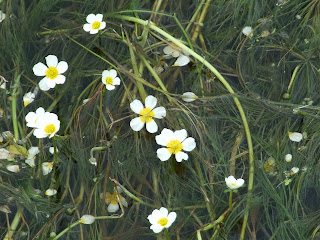Water Crowfoot (ranunculus) should be a seasonal expectation on high quality chalkstream rivers, so it was a pleasure to see so much early growth in evidence today. Whilst it's perfectly possible to canoe and kayak through such growth (see the seventh picture here), the upper River Kennet is not really a viable paddling destination for any significant length due to depleted/insufficient water levels and access restrictions.
It looks thick enough to walk across. The Water Crowfoot above George Bridge carpets the river, and similar displays between Chilton Foliat and Leverton currently seem to attest to the health of the river.
There are a number of different types of Water Crowfoot, but healthy chalkstream rivers are typically characterised by this plant growth from April to August.
The local lambs at George Bridge appreciate the soft waterside growth but ranunculus species are essentially poisonous to grazing mammals.











